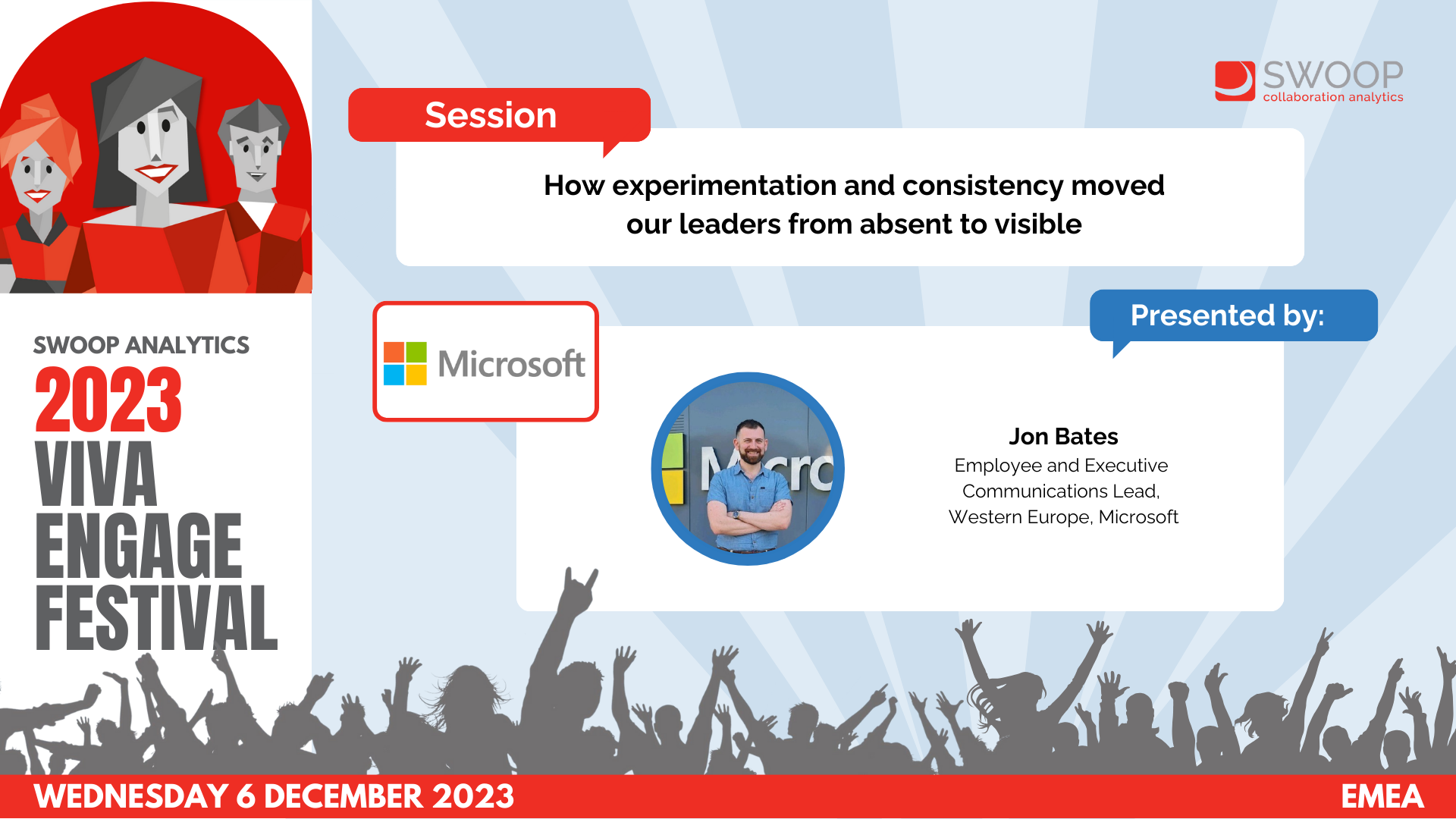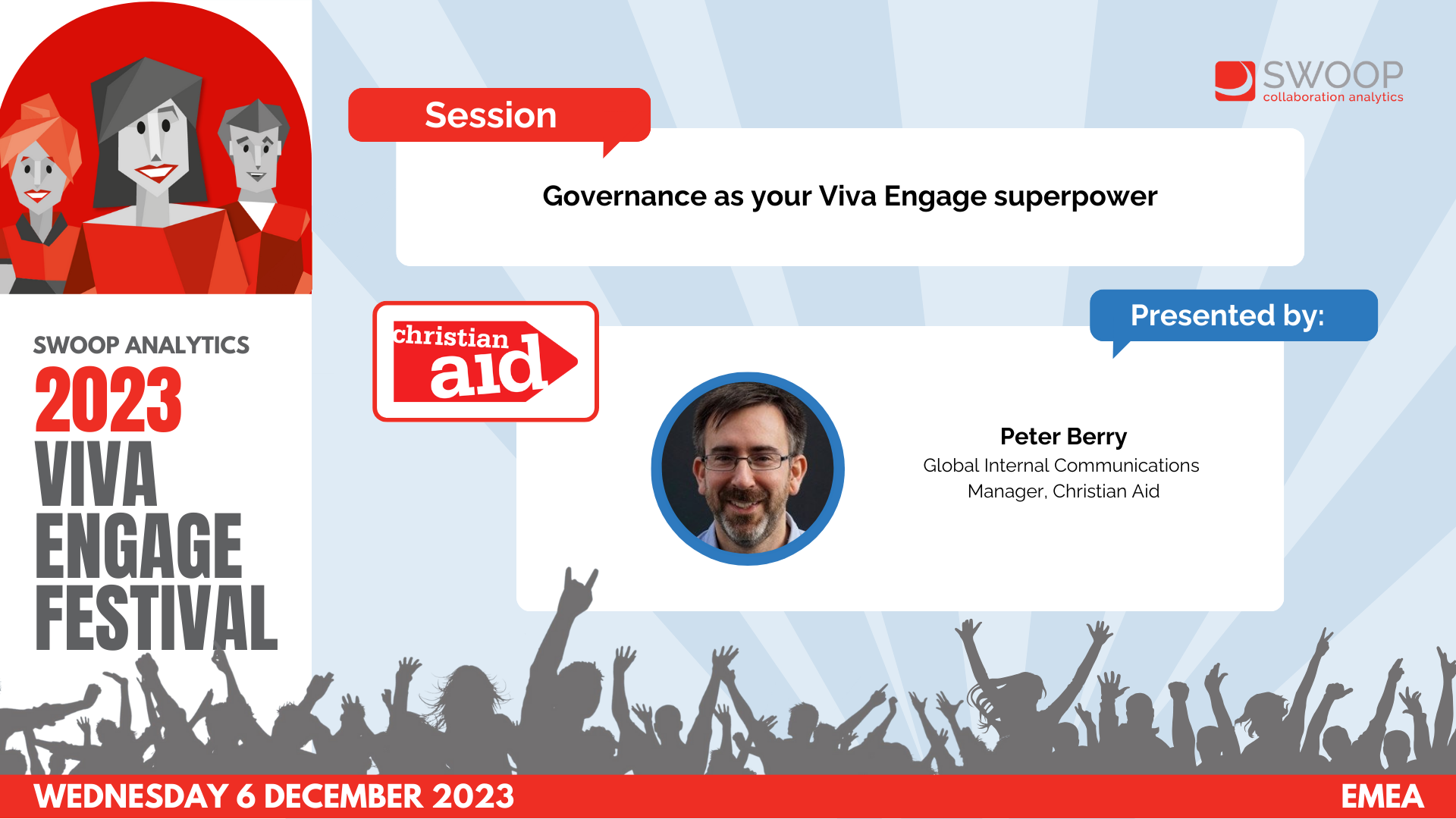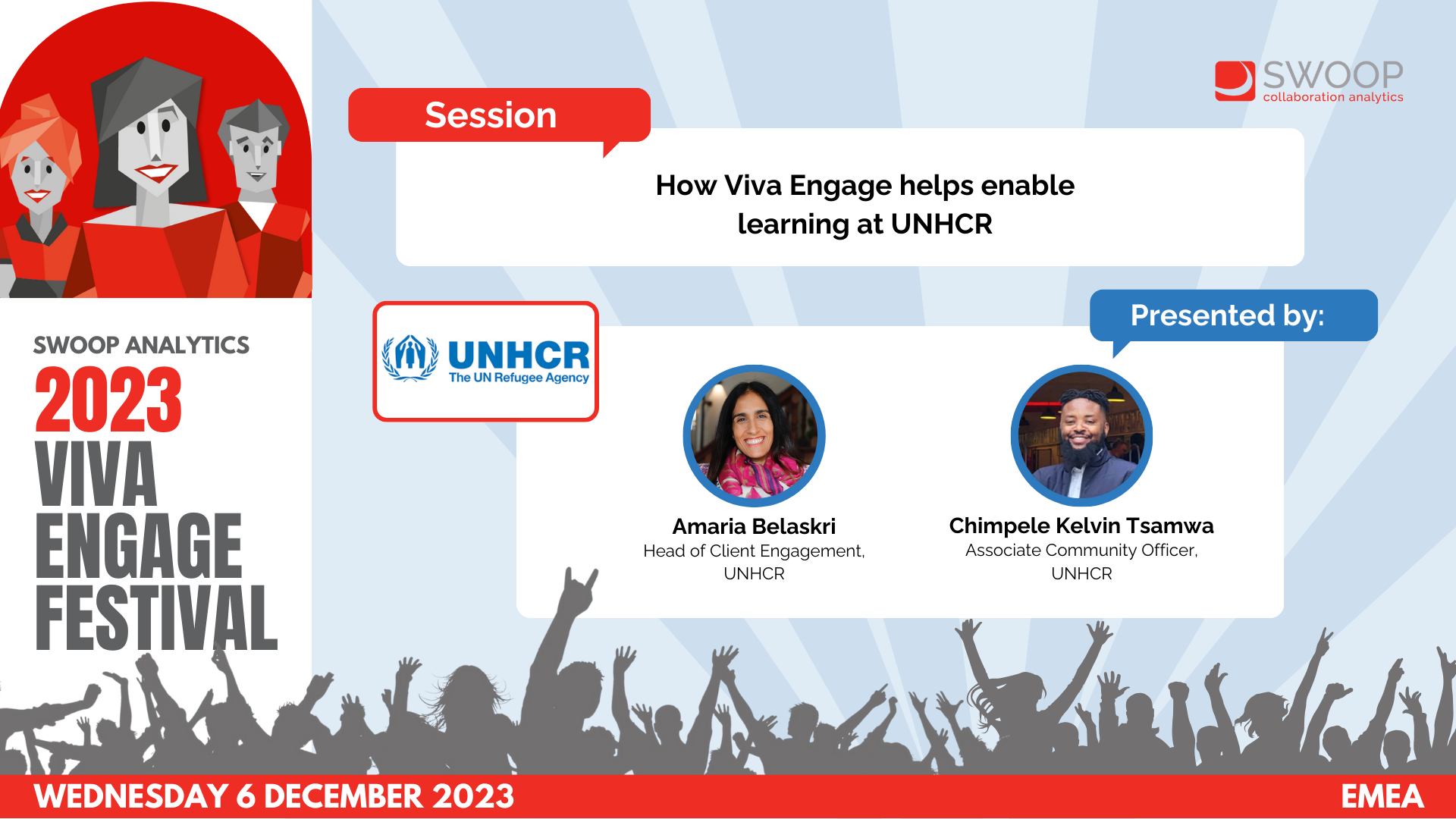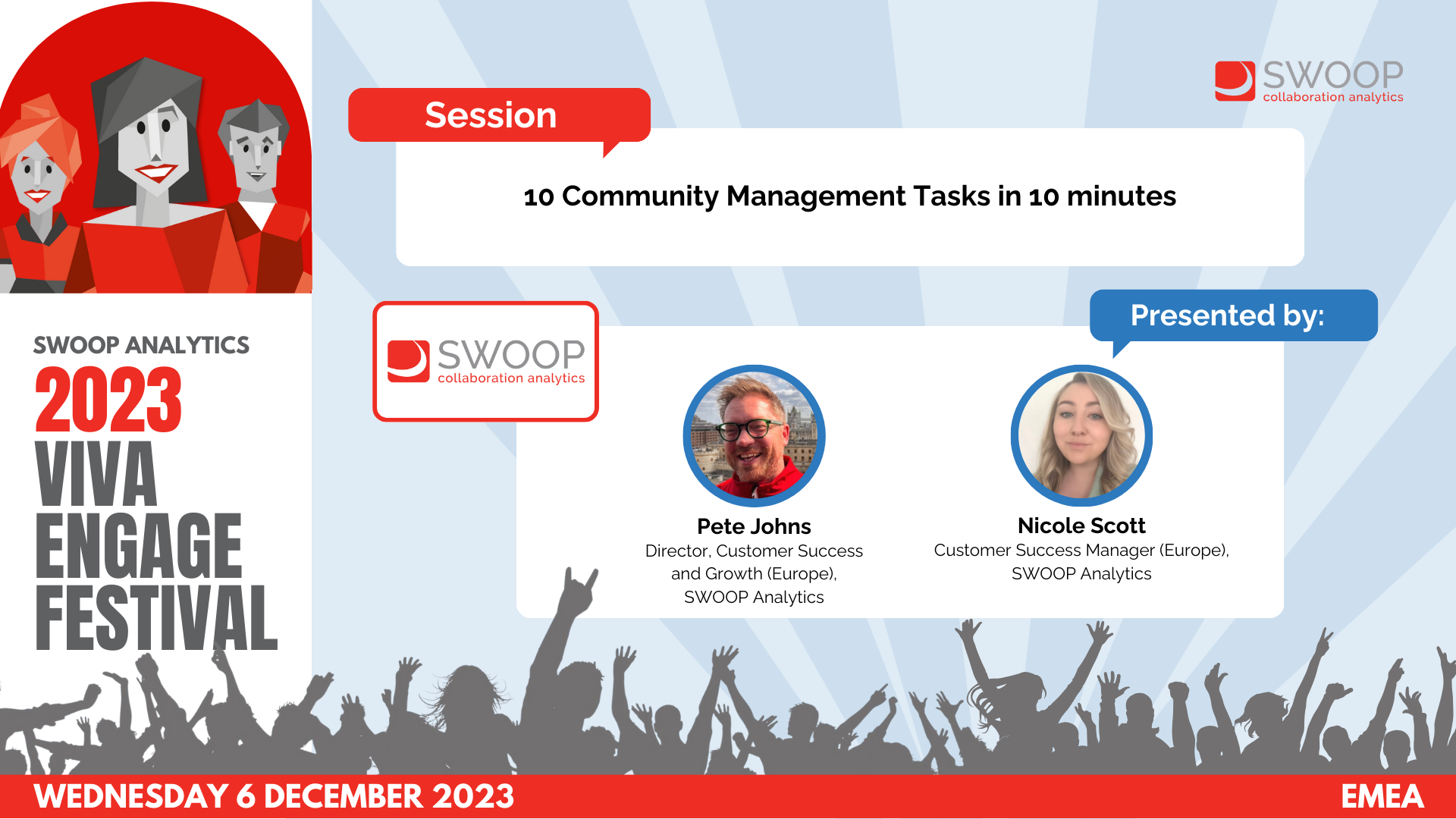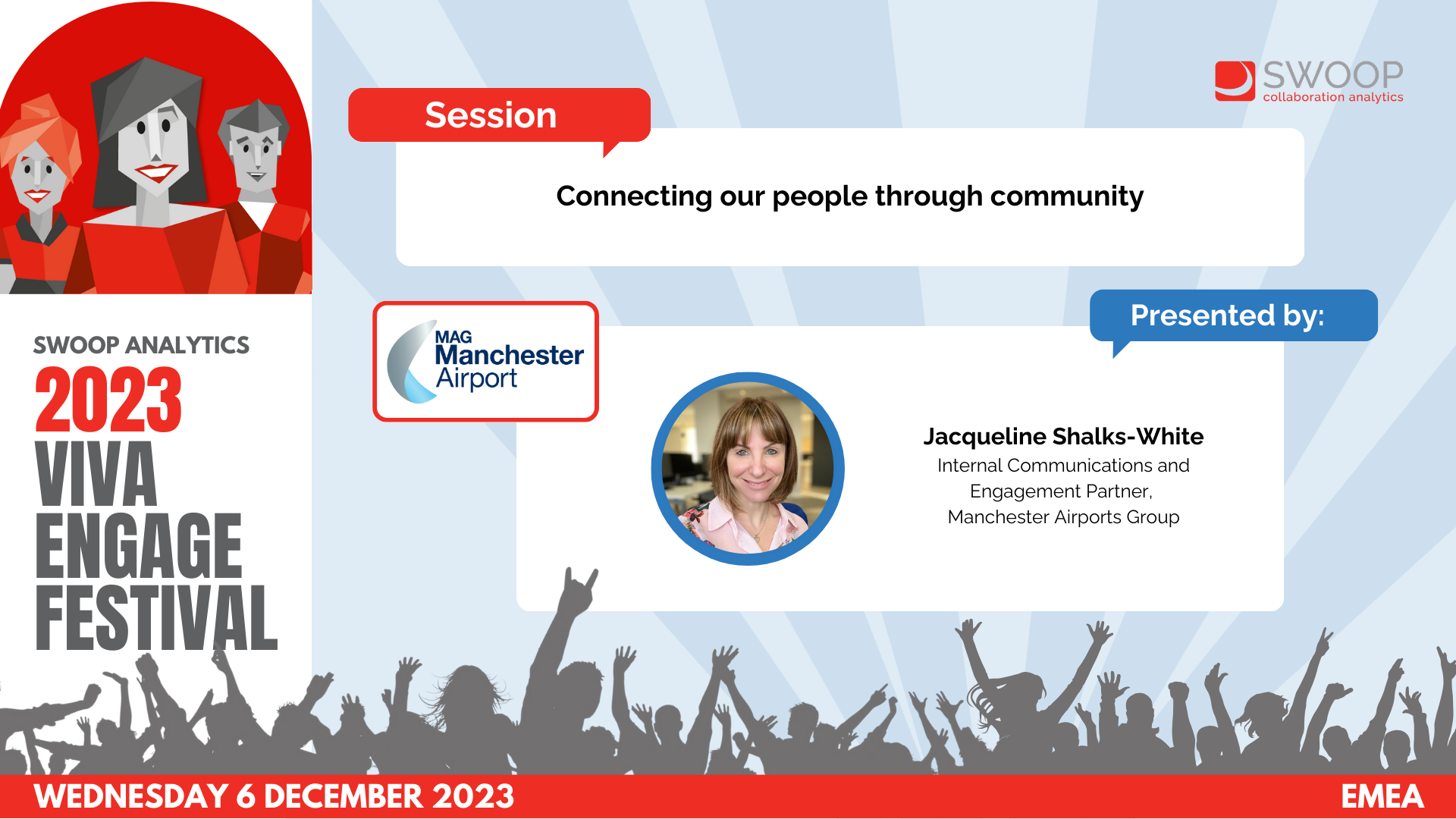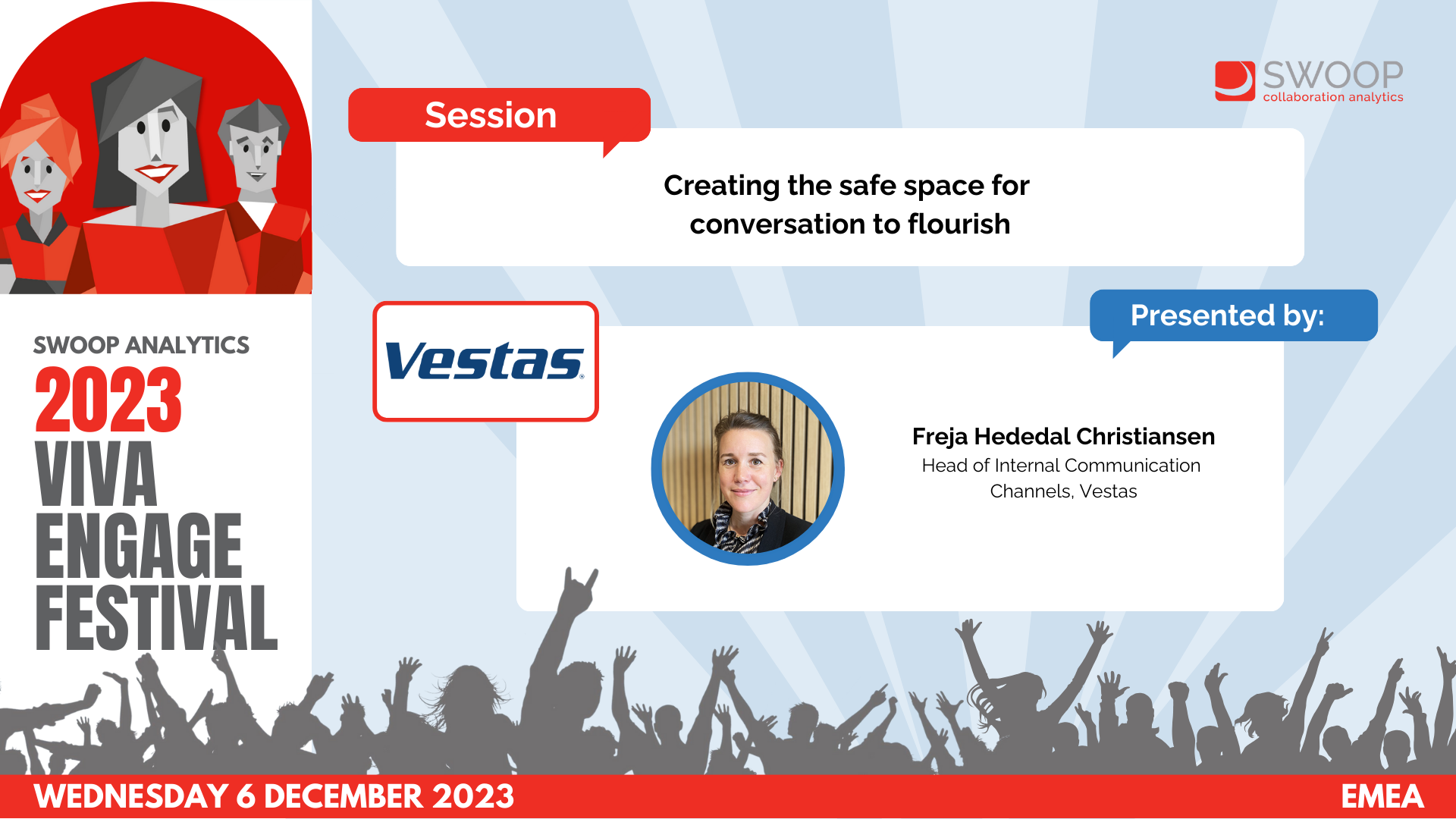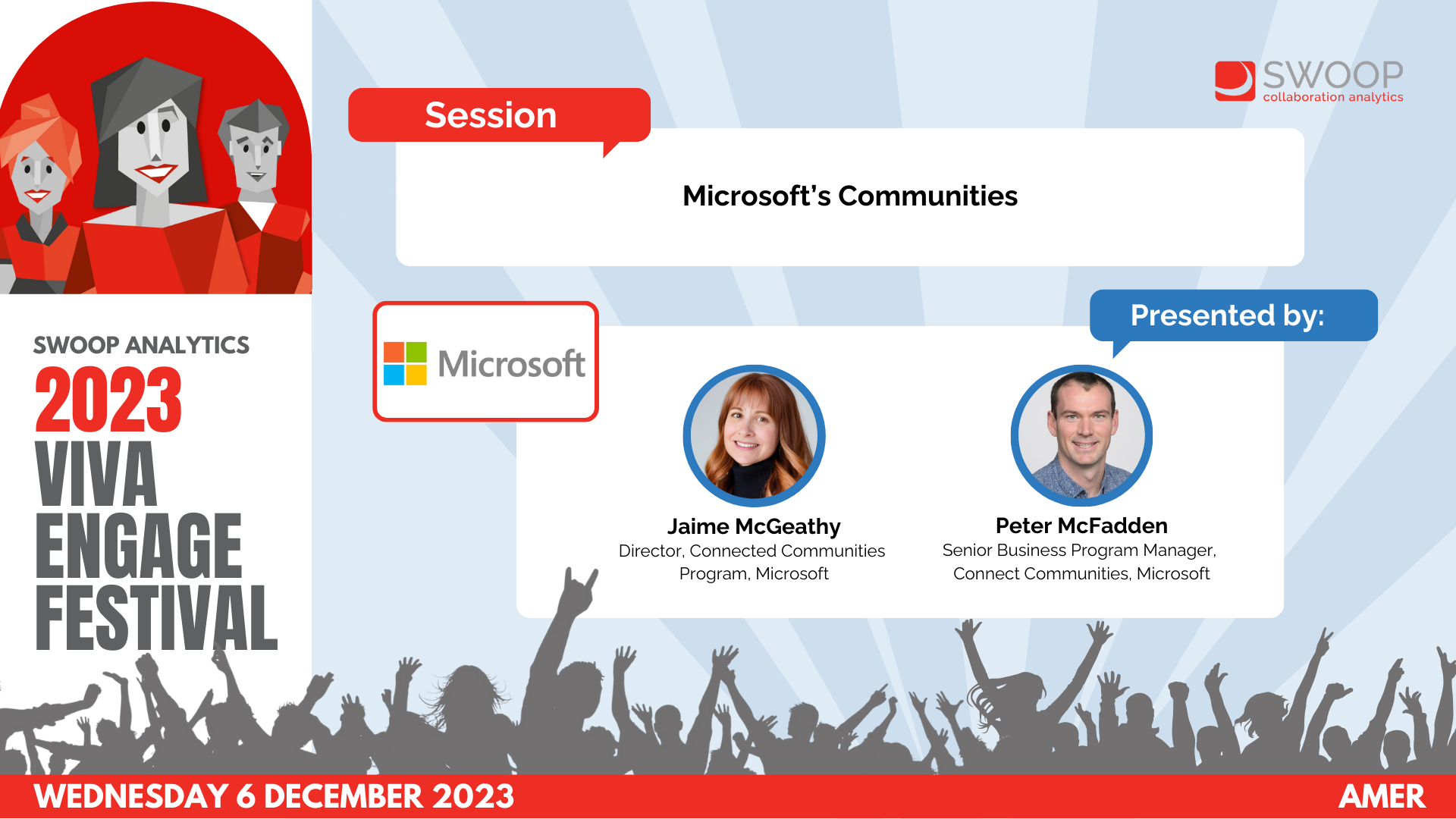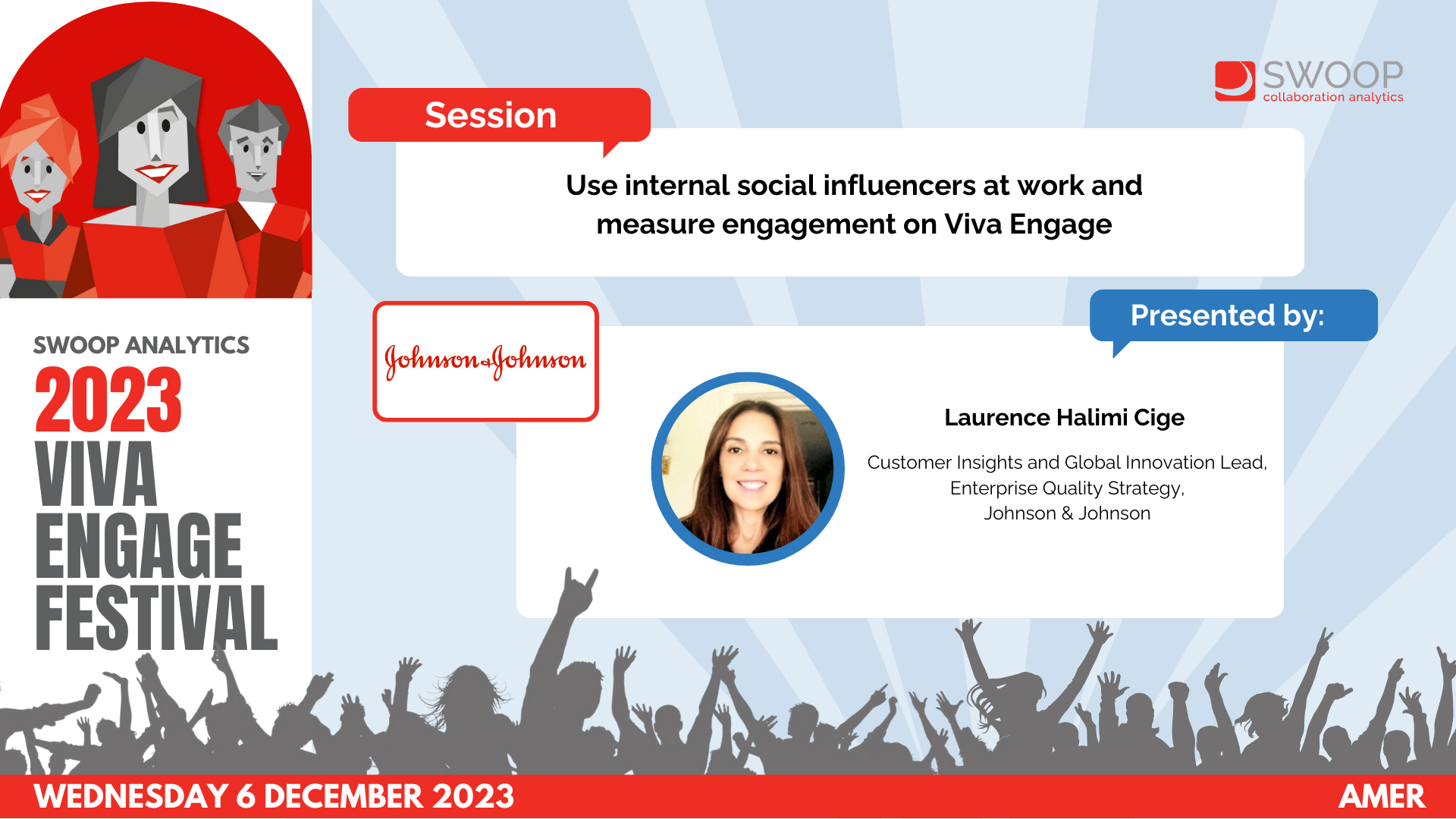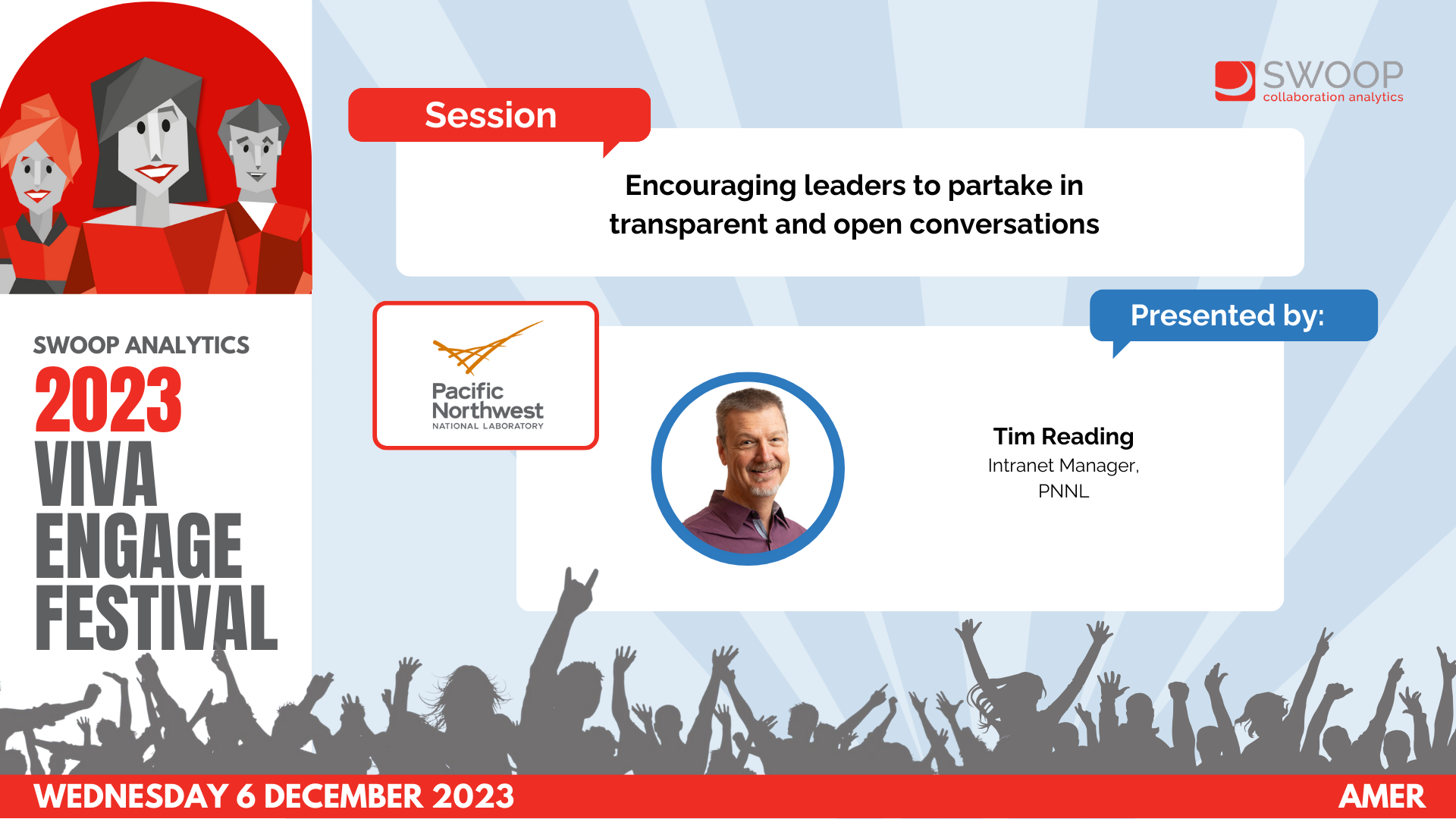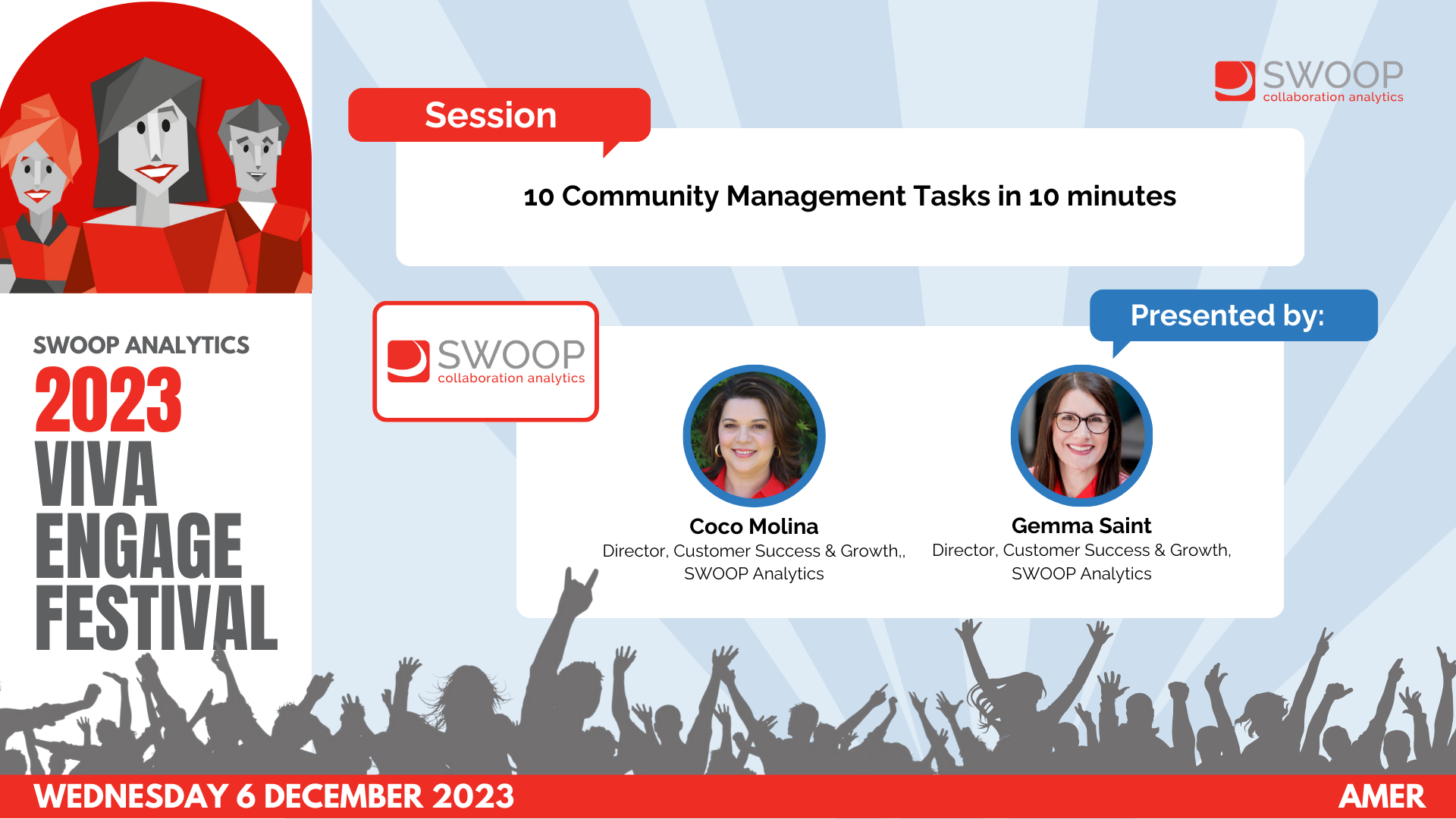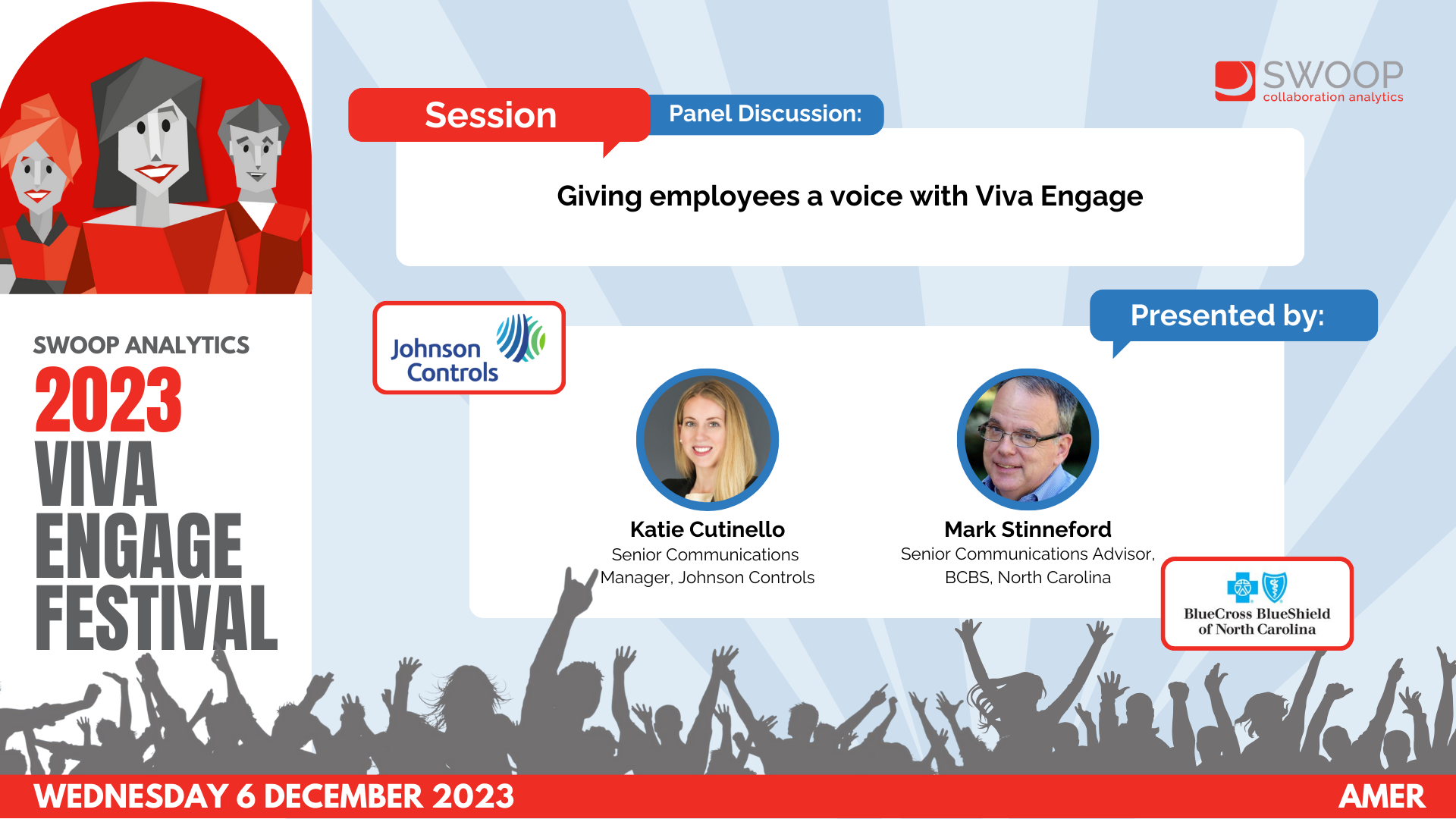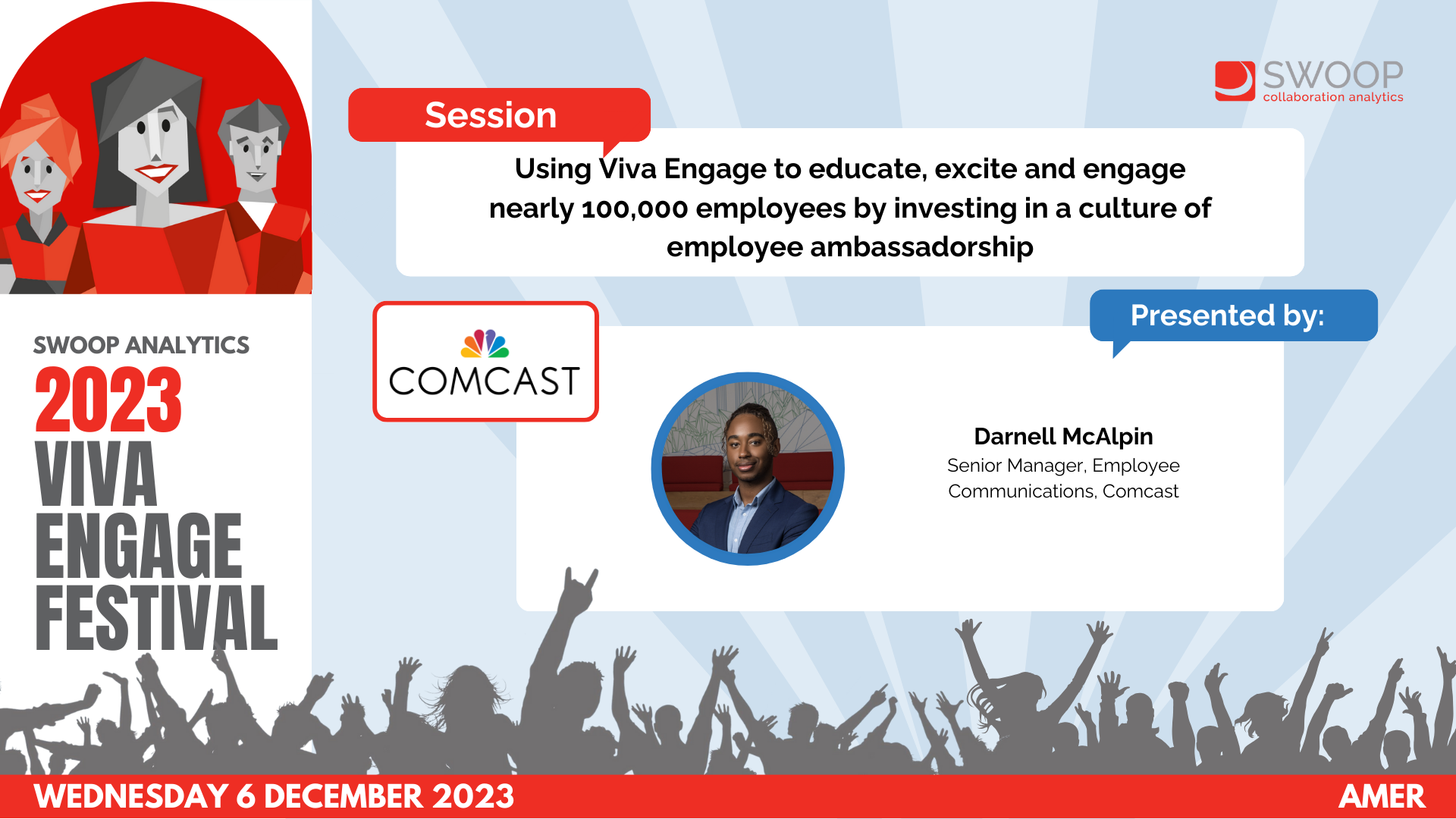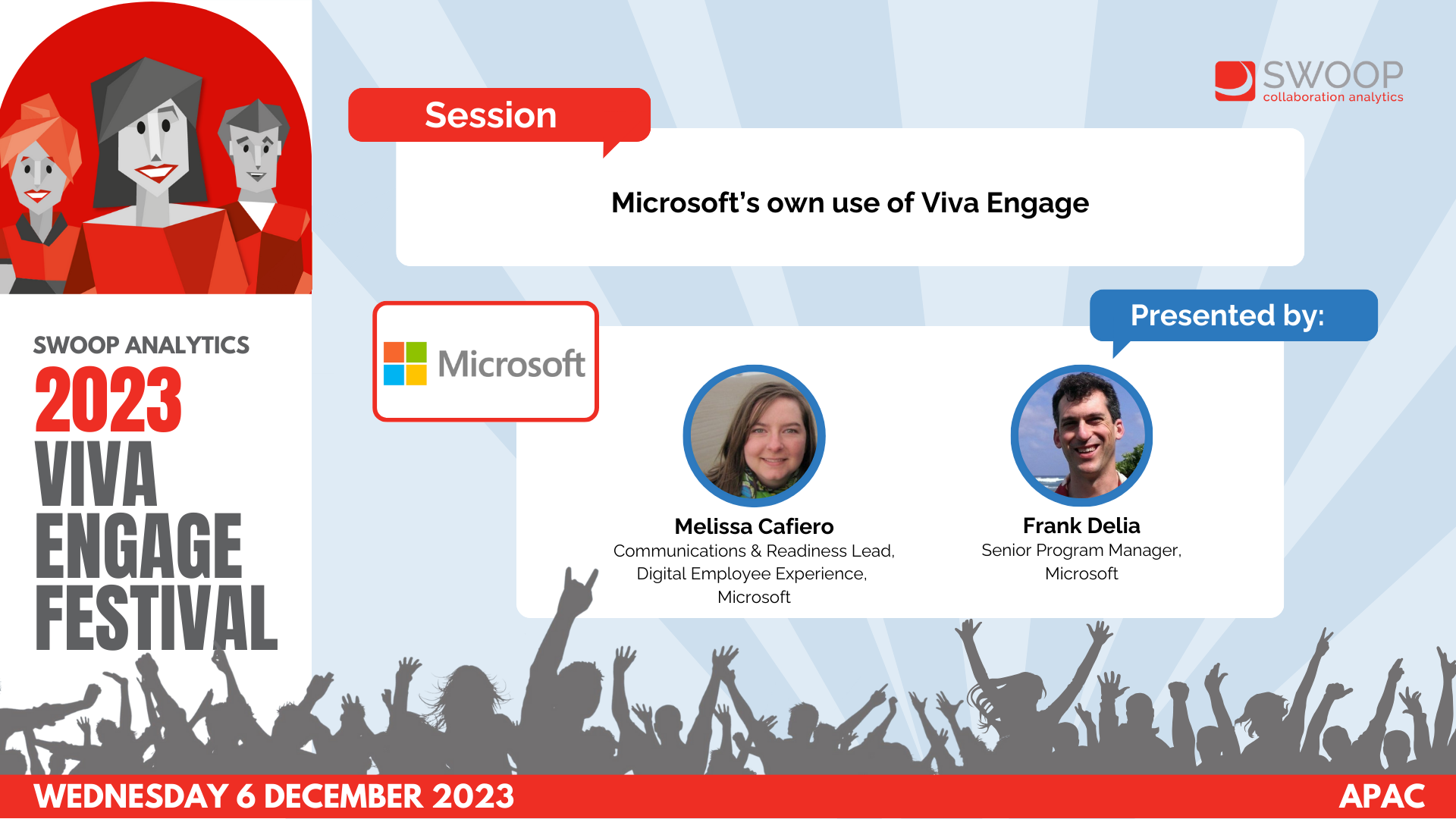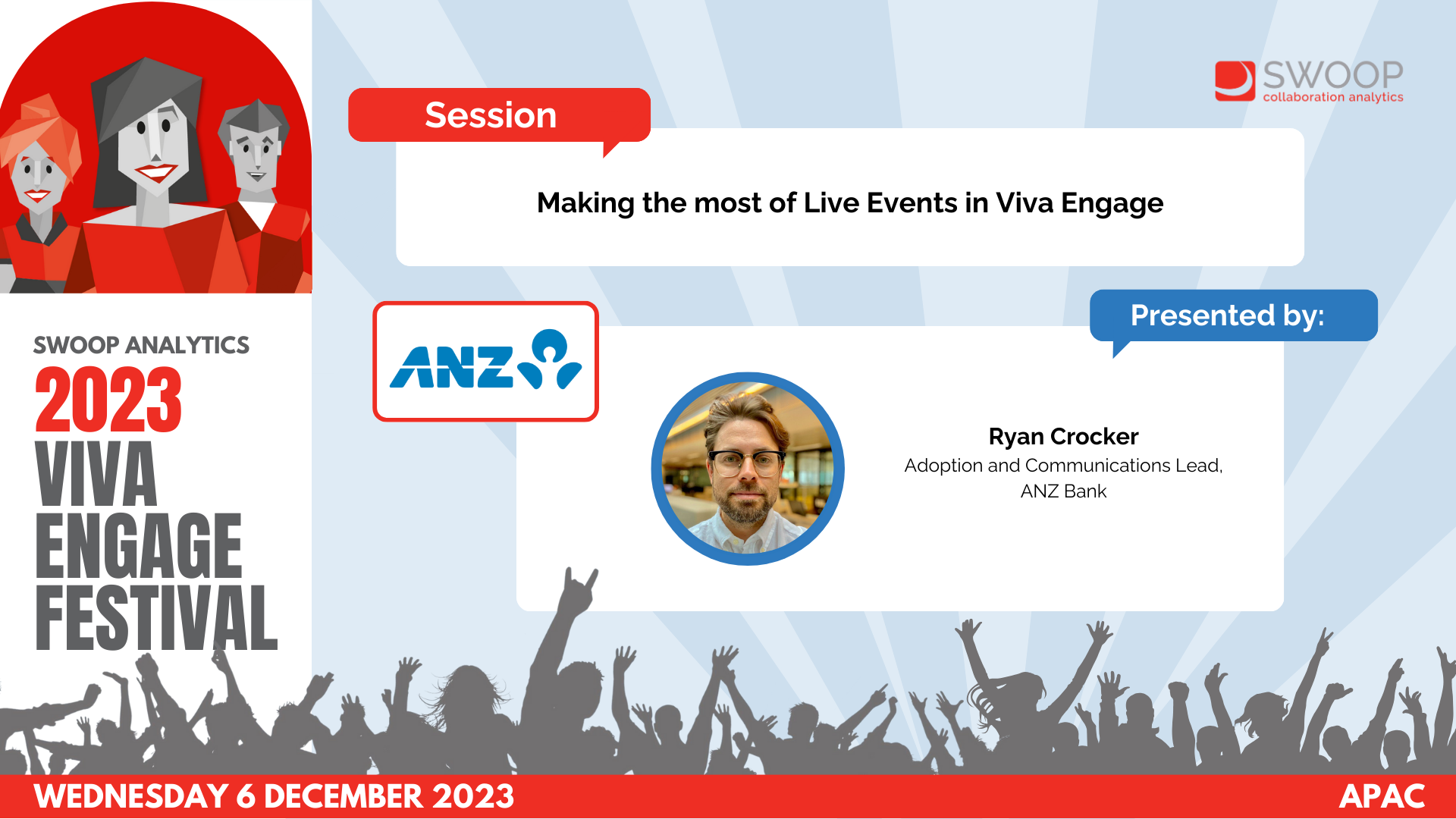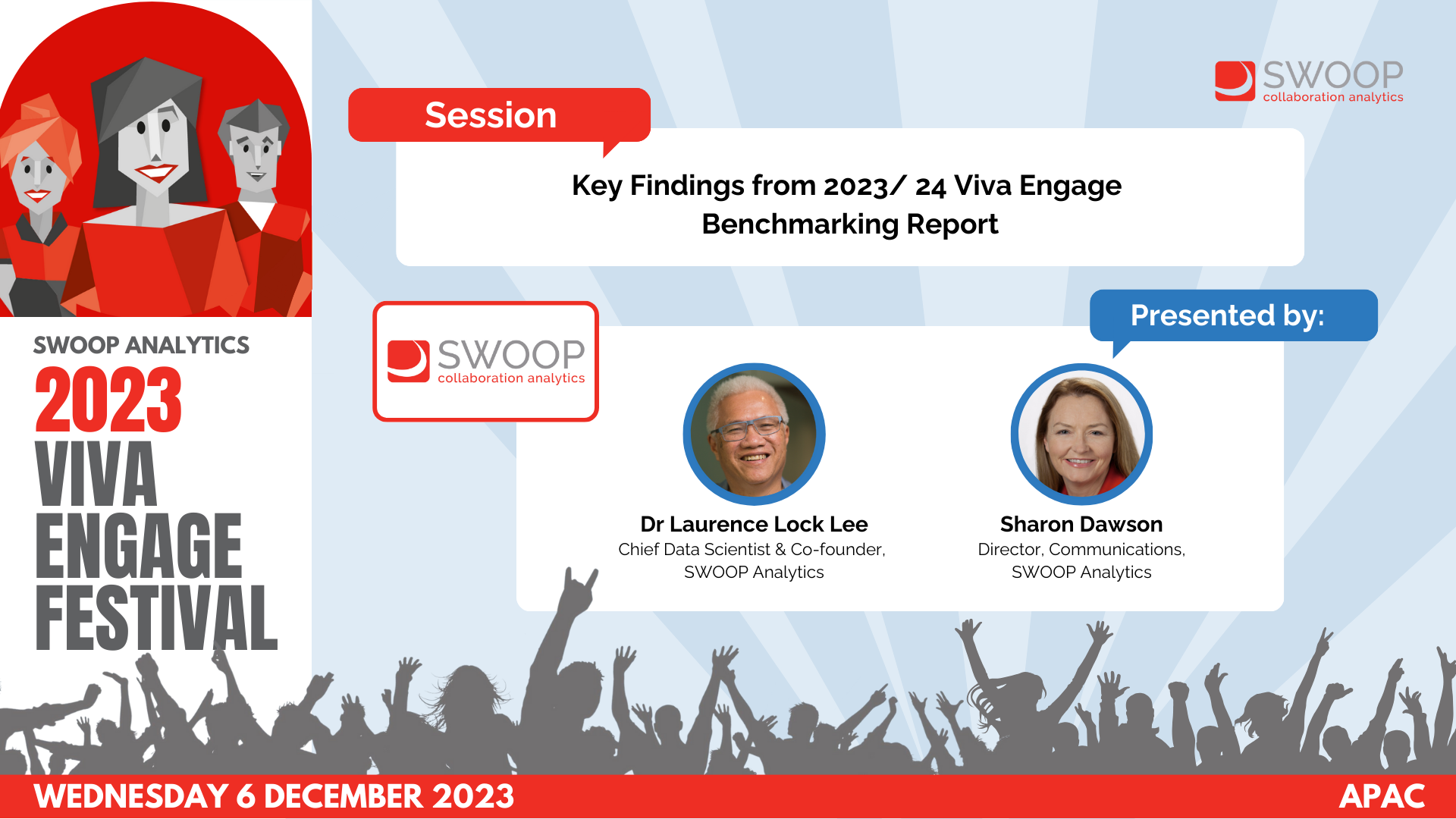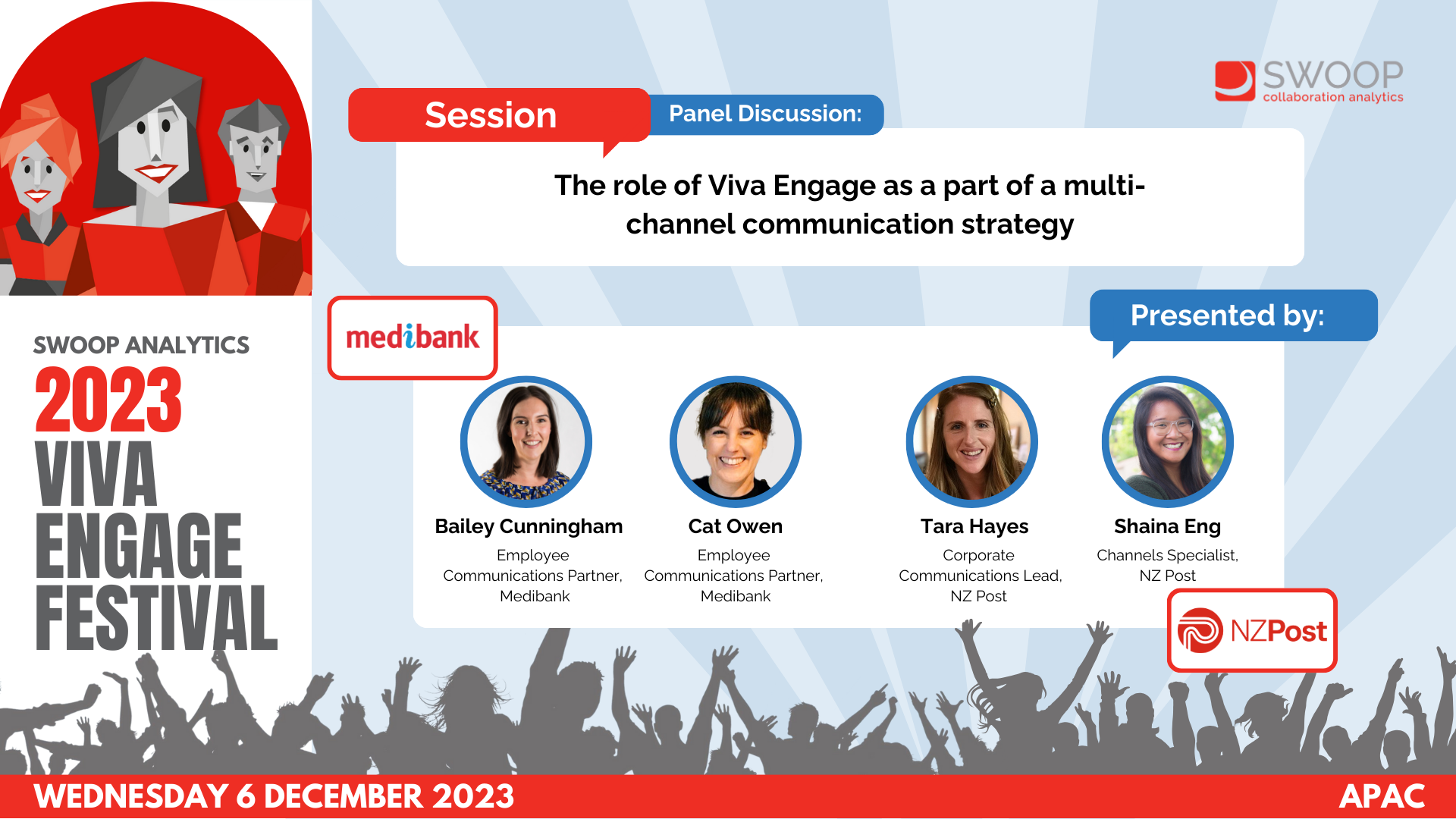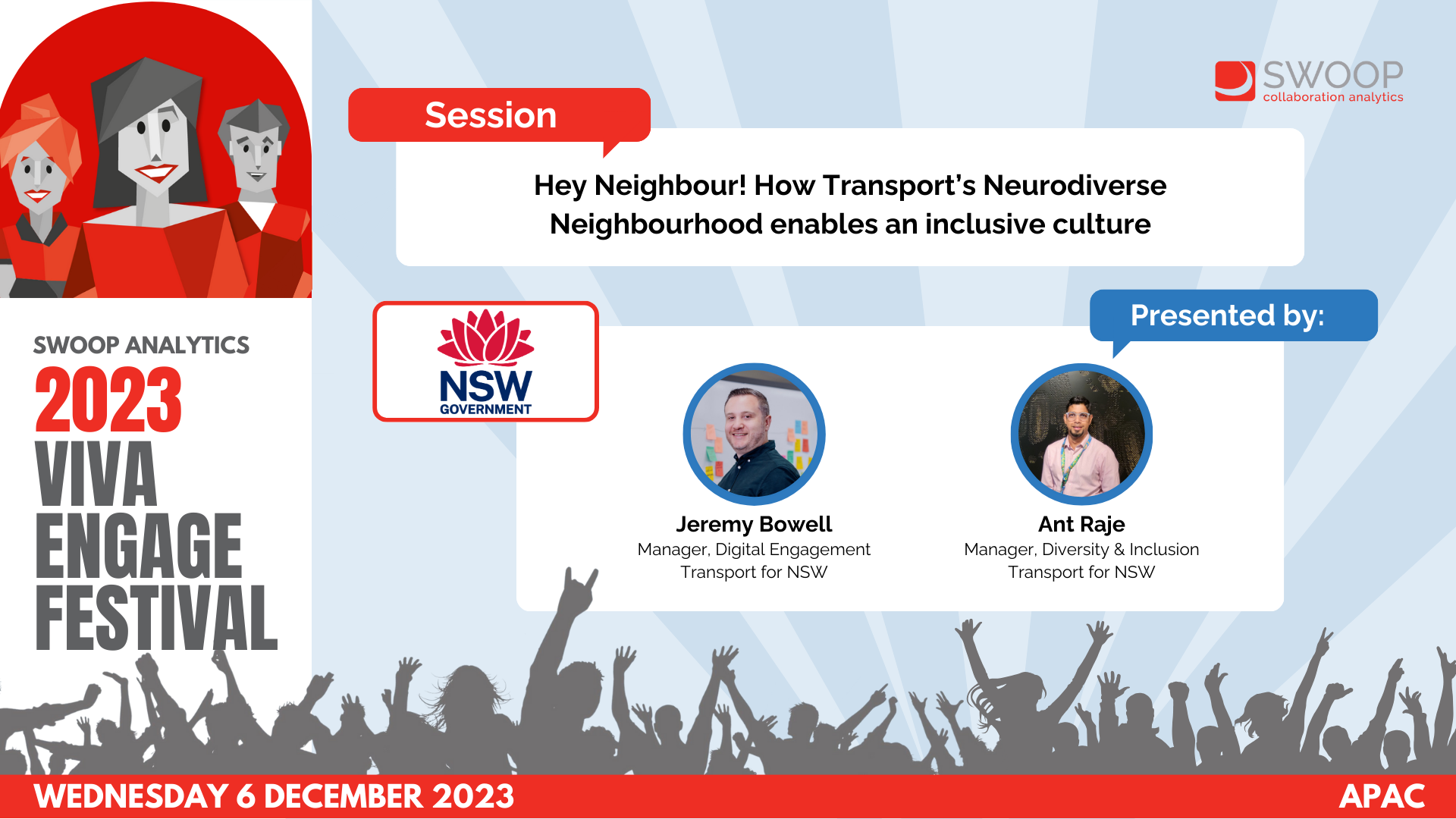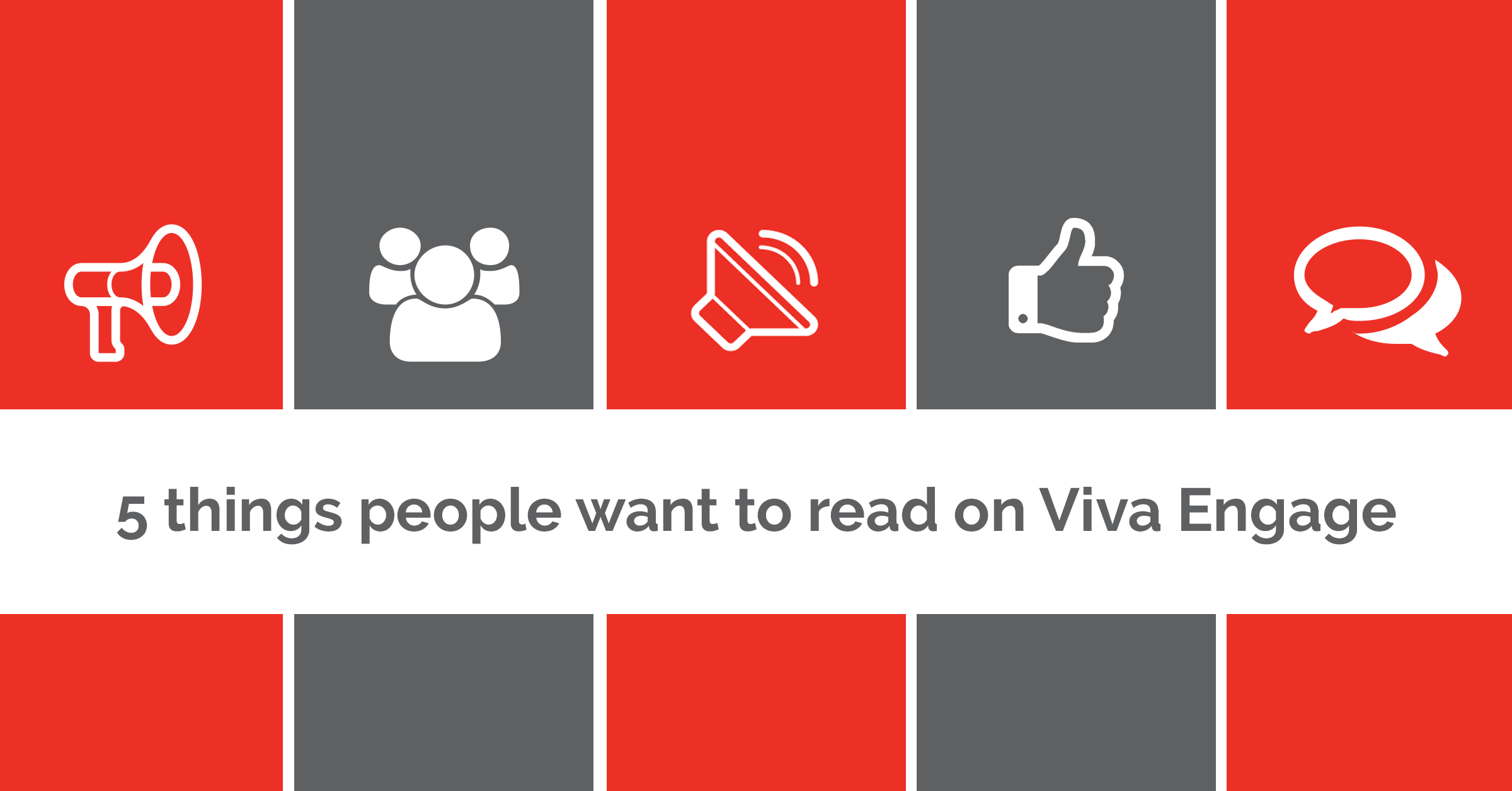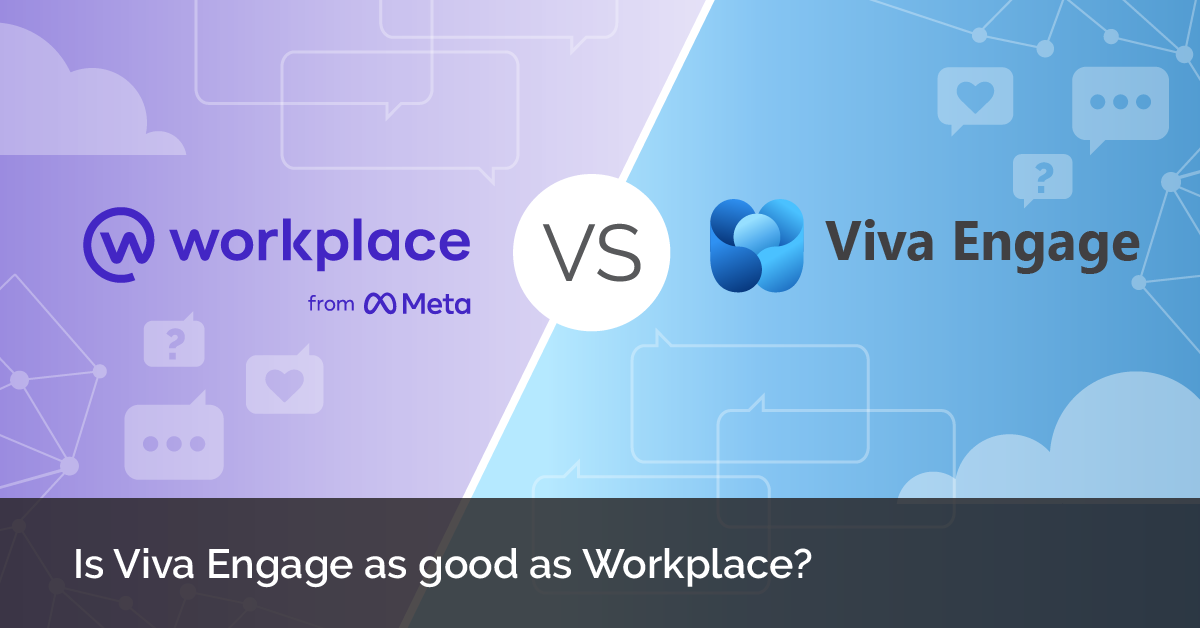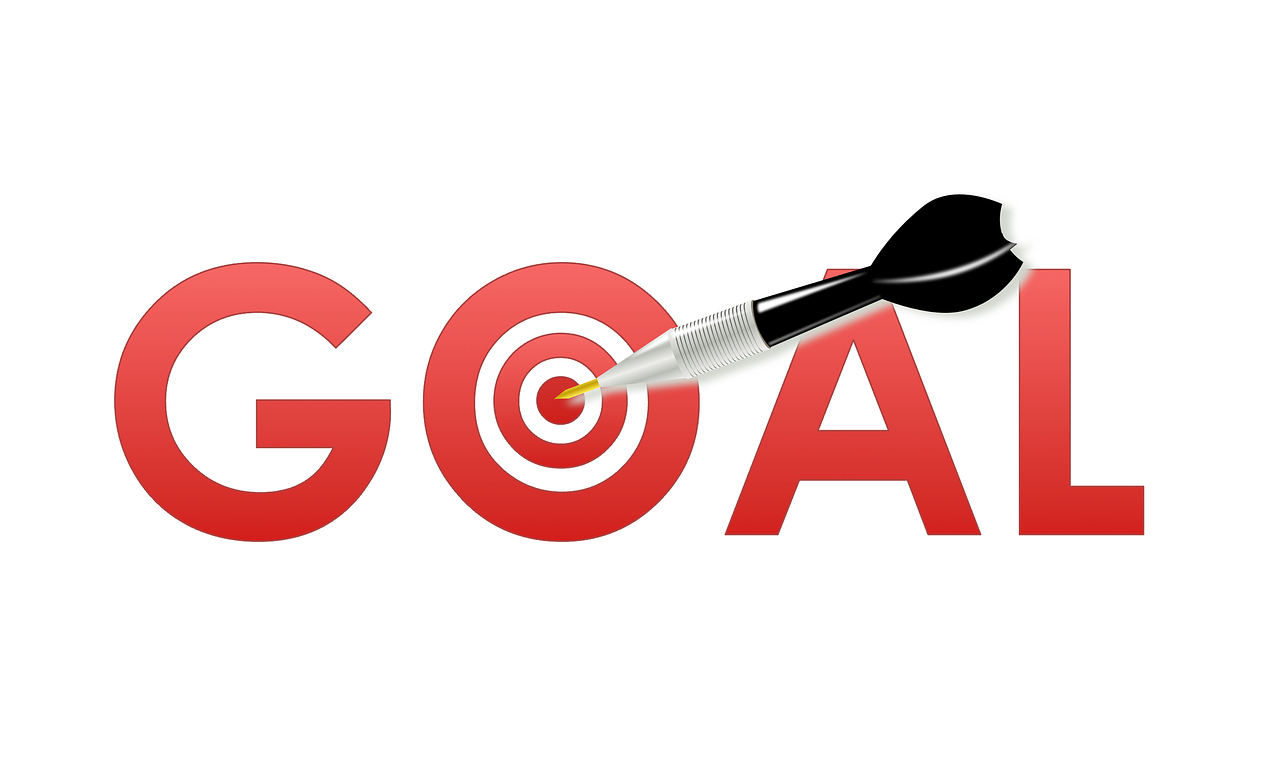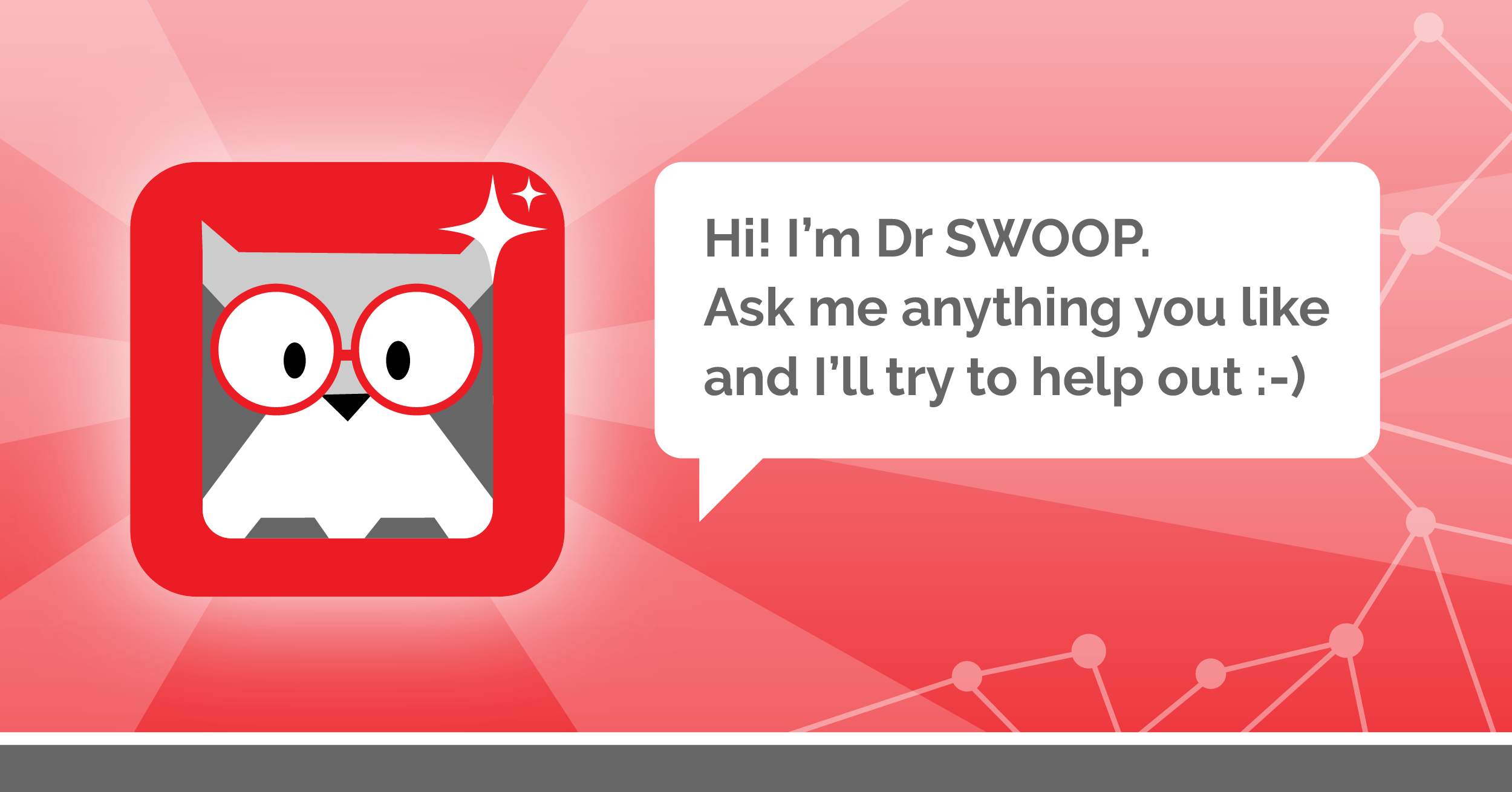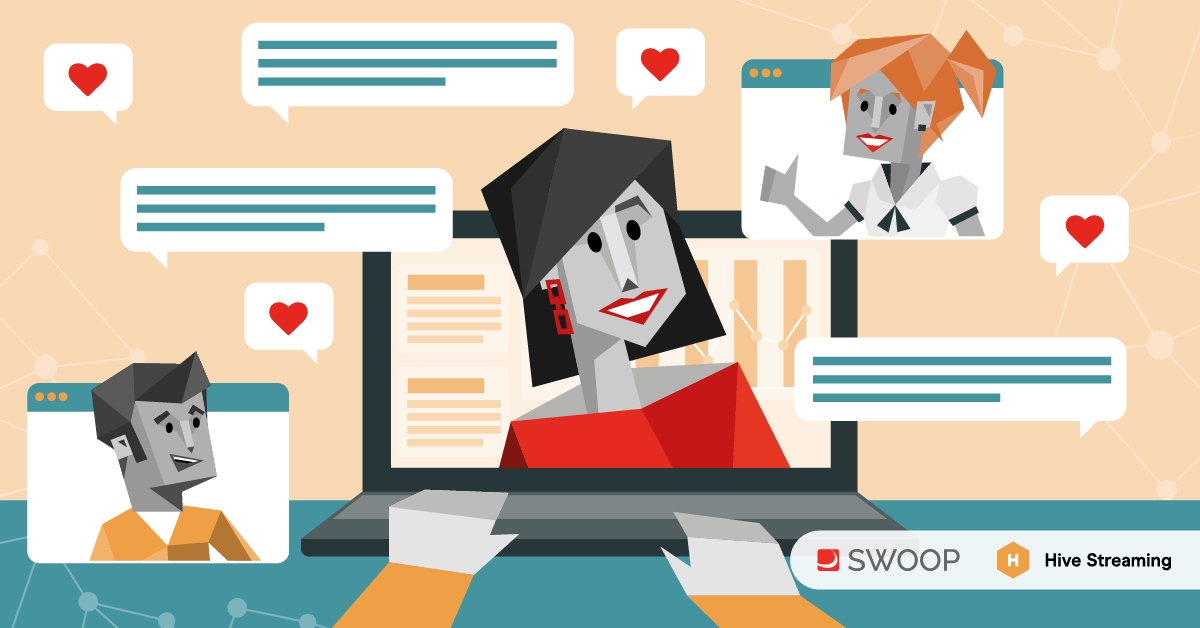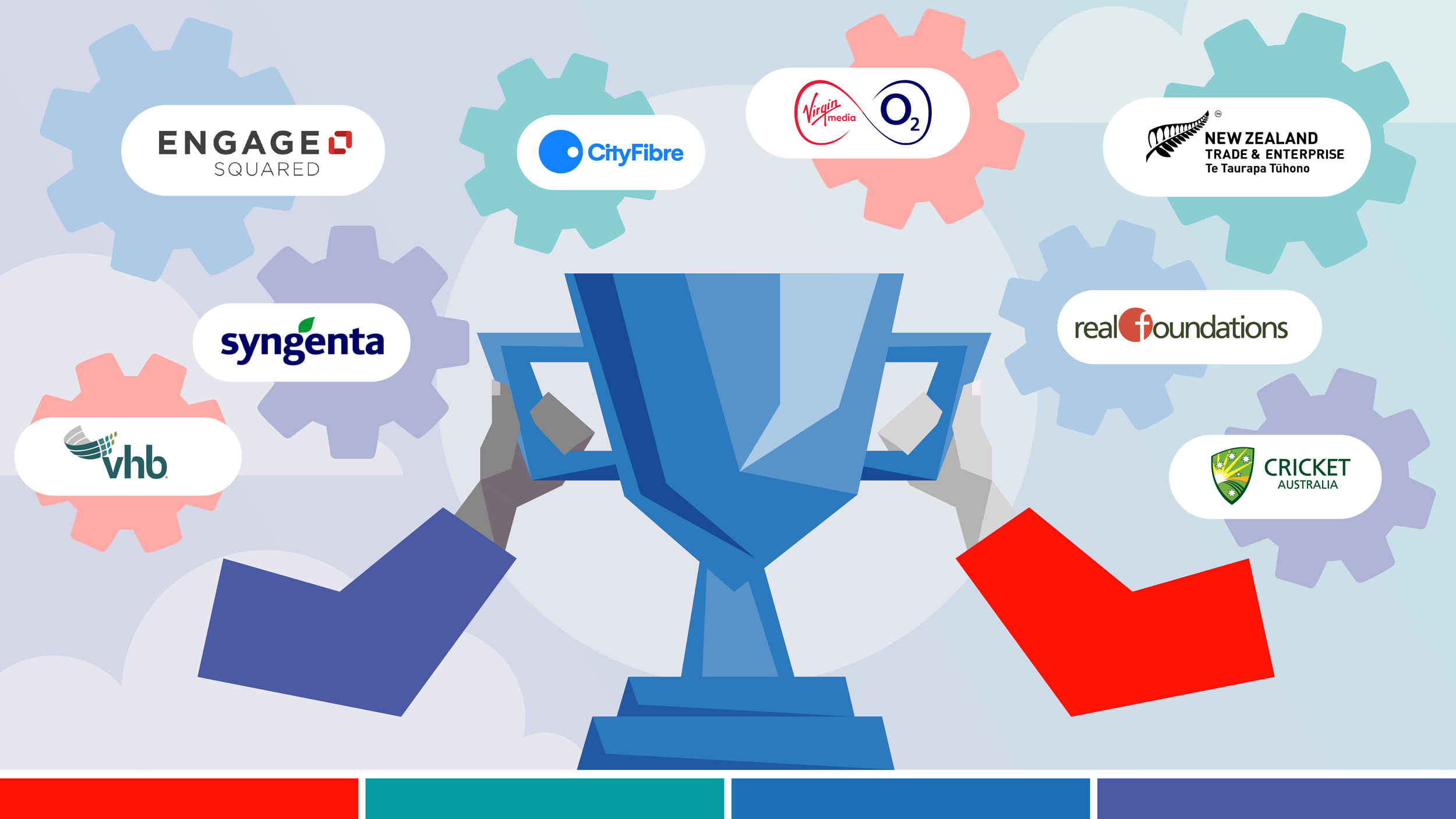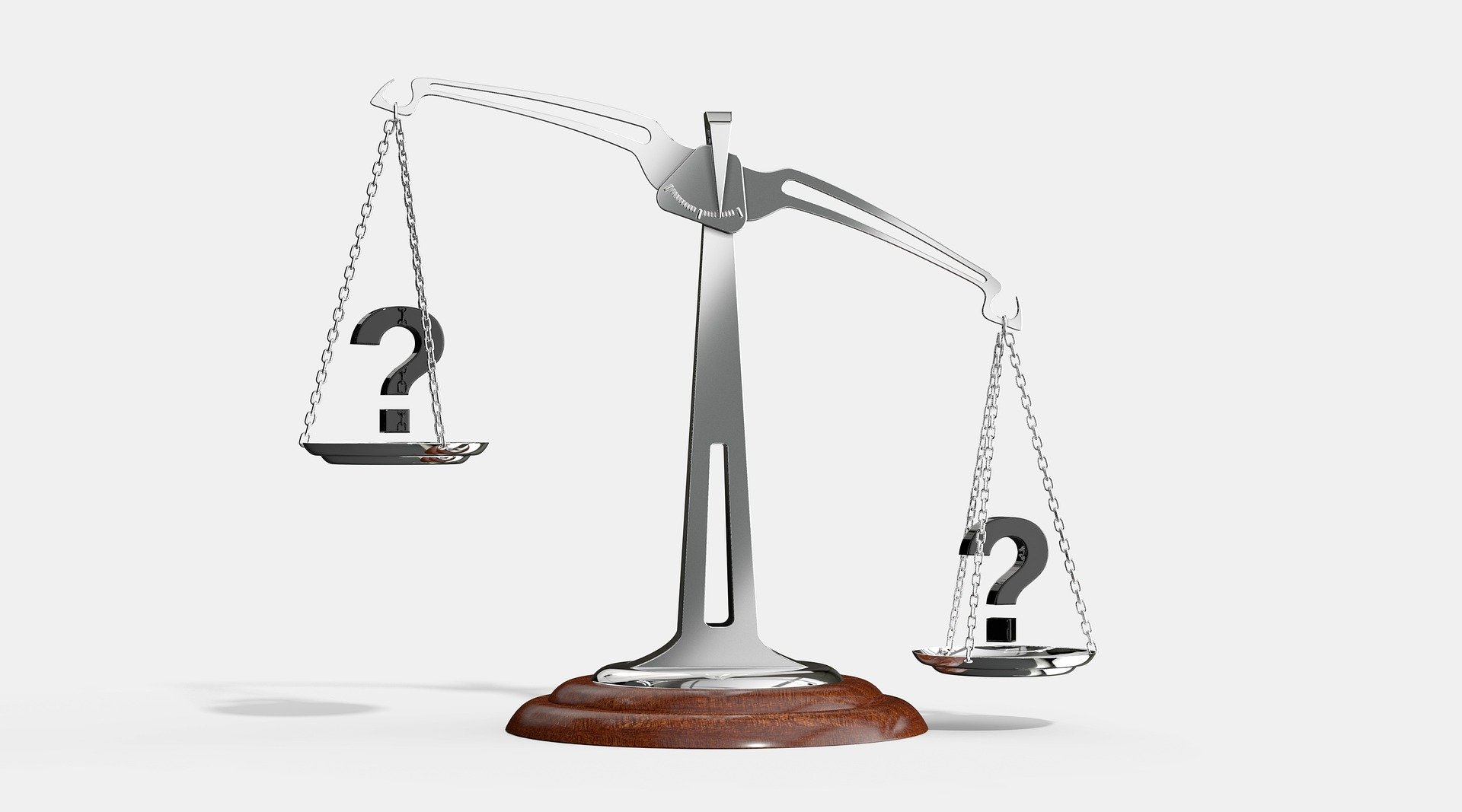ANZ: Making the most of Live Events in Viva Engage
APAC | Viva Engage Festival 2023
Gain insights and top tips from the world's No. 1 Viva Engage network, recognised in SWOOP Analytics' 2023/24 Viva Engage benchmarking study. Hear from ANZ to discover how their team have been leveraging Viva Engage Live Events and the valuable lessons they have learned throughout their experience.
-
Well, thank you very much for having me to come and speak with some people today and recognise some familiar names and faces. So it's good to see everybody gathering again for some best practice chat on Viva Engage. And so just before I go into what I was going to talk about.
Actually, your little role play there, that was perfect. I mean, they're all the things that we take our leaders through. So I feel like that was 10 minutes.
After that 10 minutes, I'd be well prepared to walk into a senior leader's office and take them through. So it was really, really good. And just a kind of like a bit of anecdotal proof that the liking action is really, I suppose, there's a lot of science and data behind it.
But I'm here to say it works in real life as well. So at ANZ, we actually created a chart and we looked at the number of likes on any given month that our CEO dished out to others. And we compared that against the number of people who read at least one of his posts in that same given month.
And what we actually found with it was it was incredibly strong correlation between those three things. So you could literally see his audience growing and shrinking based on the number of likes that he dished out in that given month. So it really is so much power in something as simple as a like.
So, yeah, really, really good advice and insights there on that. Just a bit about ANZ for those that don't know, we're a bank. I think many of you will know that, but you may not as well.
But what you might not know is that we're not just an Australian bank. We're not just a New Zealand bank, but we actually operate across close to 30 different markets across the globe. We serve around 8.5 million retail and business customers across a range of industries.
And that is everything from customers who want a home loan or a credit card right up to small business customers, medium, big business customers and global, huge institutional customers. So there's a whole different range of expertise and different priorities across the bank. We've got more than 40,000 employees working across those 30 different markets.
So there's a lot of, you know, it's a big crew to try and keep connected and to try to keep engaged and aligned on strategy and, of course, aligned on our purpose as well. So very, Viva Engage plays a really important role for us in helping to connect some of those groups of people together. And so, of course, I'm here to talk about live events.
So we are, I would say, we just sort of like many organisations, just starting to dip our toe into the world of live events via Viva Engage. And I'm sure people have a lot of questions about, you know, what they're best for, how they work, the kind of things you need to plan for and think about in order to make them successful. And we do still have a lot of those questions, but thought it would be good just to share a couple of different examples of what we've tried so far and what we've learnt so far as we've experimented with it.
And I can tell you we've had some really successful examples and then also some not so successful examples. So I think there's opportunity to learn from both of those. So I'll start with the successful one.
So in our business, I mentioned earlier that part of our organisation serves and looks after the really large institutional customers, and that's called our institutional business. And our big value proposition for that as a bank is that we do have those access and expertise in those 30 different markets. So a lot of those organisations are supported by teams that work in different countries all over the globe.
So that's probably our biggest and most geographically dispersed area of the business and a really important area that we need to keep connected and feeling that sense of connection back to the bigger picture. So each year, and this isn't a new thing, this has been going on for some time, that team hosts a big event. We call it INSTO Connected.
The business is institutional. We call it INSTO for short. And so that's a it's a massive event every year because you're connecting across borders, time zones and there's always tech implications and all sorts of things that need to be thought through there.
But the aim is to help that audience be more connected to the strategy and feel like they're part of the broader team. So this year, the team are always the team running these are always trying to do something different as well to make it fresh and exciting. And so the perfect opportunity this year was we just enabled live events via Viva Engage at ANZ and we thought, what better way to test it as the first cab off the rank with the biggest, most important, most complicated event that we run internally each year.
What could go wrong? And so we were a little bit nervous, to be honest with you. Like my team weren't running it. We were just sort of advising on the Viva Engage front.
But yeah, definitely a few nerves there in getting that to work. But it really, really worked. And there's a few things that I want to share in terms of how we know it was successful and the big benefits of having it on as a live event on Viva Engage.
So as we as you know, and sort of you've probably heard talked about is the biggest the kind of value proposition for having a live event on Viva is the fact that you've got the engagement before, during and after the event. And you kind of can capitalise on that content. You don't it's not a sort of a flash in the pan, a couple of hours on Teams and then it's gone and you lose all that rich discussion.
So sorry, could we go back to the previous slide before we go into it? Thank you. And so that's the main benefit. And so what we saw in terms of the results were where there was I think it's about three and a half thousand people that attended the event and watched it to the very end.
So we didn't have any drop off. But the thing that was so amazing is that the viewership of the event doubled within a week after the event had happened. And we would never have been able to achieve that if the event had been hosted in Teams, because while we'd get the recording, we might publish that on our intranet.
You don't get people going back in and looking at it traditionally. So that was a massive benefit to having it on Viva Engage live. And then it also enabled the team to do things like share photos of where they were joining from.
So you can see on the screen there, there's some image that people submitted from their different locations across the globe of their team joining in. And we were able to run lots of sort of fun polls and sneak peek teases of the content that would be shared at the event in the lead up, have some really great audience interaction during the event. And then obviously we got that massive bump in engagement or not the massive bump in engagement, but the engagement clearly continued well after the event was ended as well.
So the things that we put so much work and effort into the detail and making run really smoothly, that kind of payoff of having it have the lot of having the life of the event kind of extended beyond the event itself was a real value add. One of the really cool moments that we were able to orchestrate through the planning was the somebody posted a photo of themselves in the middle there. You can see they were enjoying some samosas while they were joining in.
And in the background, we were able to have a team sort of following that conversation, jot down things on notepads, run them up to the presenters, which is a bit manual and behind the scenes, but say, hey, someone's just posted a photo of themselves eating samosas so that the presenter was able to then say, oh, oh, I'd love a samosa right now, you know, and actually bring that real live element in that real that connect those kind of two worlds, which is the broadcast event and the conversation going alongside it together and create a really kind of schmick and connected experience. So on the next slide, just a couple of tips that we sort of learned that really helps make that event a success. So in some of these might seem really basic, but they are quite important.
So creating a landing page for your audience and it's probably best to do that on a SharePoint or an intranet site because you need something static that just really details for people this format is going to be different. Here's how it will be different to a live event on Teams and explain how the audience interaction would work. Give them the calendar invite and tips for participation.
I've got an example post in this deck as well with what the tips with the tips that we provided for people and just never underestimate like and I can say this is as Emily called out, I'm not blowing my own trumpet here. Emily said this earlier that we were one of the top performing organizations for large companies globally. But even here, we absolutely have to, there are people that don't use Viva Engage and quite a lot of people that don't still don't really understand the value proposition or it may even have reservations for being on a public social platform and not really feel comfortable with that.
So never underestimate the need to sort of do that pre-engagement with your audience so that they're primed, they're confident and comfortable and ready to go. Promotion is another really important one. So you can, if you typically you'd be creating a lot of really interesting, compelling content for your event.
So just make sure that you're repurposing that in the lead up to the event as well to start the engagement early with questions, polls and teases and ask your presenters to lead the activity. So it's kind of then getting people excited about your hearing from your subject matter experts and your leaders, seeing them visibly present on the platform before the event as well is a really good way to generate some excitement. And then roles.
So I gave the example earlier about that kind of connecting the two worlds. So the online conversation with the virtual presentation. And that's a lot of planning and a lot of people to make that kind of thing work.
So it's a kind of another level to the roles that you need to think about before this the event runs. And I'm sure everybody who runs live events on Teams knows you need someone to manage the production and someone to manage the Q&A. And so absolutely, you need that for a live event on Viva as well.
But in addition to sort of the moderator role is obviously a little bit different because they're on the chat with the questions. And of course, the questions are not structured like a Teams live event. They are flying around everywhere.
So the moderator needs to be really good at catching, staying on top of that feed, grabbing the questions out, highlighting them and then in an offline way, whether it's by pen and pad or a separate Teams chat, getting the questions to the presenters so that it does feel seamless as if the presenters are actually looking at the conversation and picking the questions out themselves. And then in addition to that, you also need your responders who are the ones in the thread. So what we've found is you what I mean, what you would typically do if you're doing a traditional Teams live event is you'd have maybe a panel, a couple of backup SMEs that if you get questions that the presenters aren't experts on, you've got extra people to chip in.
So you need that group still. But then you need that group again of people offline to manage the conversation in the chat, because answering the question in the live broadcast obviously doesn't answer the question in the chat. So and there is a we tend to see that there is a lot of activity.
And so if you can have a separate group of SMEs that are responsible for either they might summarise the leader's answer to a question, they might answer the question themselves. But just to make sure that the conversation doesn't and those questions don't sort of hang there unanswered so that that chat experience on the live event is really good. So they're the kind of things to think about.
So it is a bit more work, but I think you can, when you do it well, really reap the benefits of that social interaction. The only last thing I'll say about that example before I move on to the next one is it was very much a broadcast with audience interaction and a little bit of Q&A and to a really broad audience in terms of the kind of nuts and bolts of the type of event it was. That kind of event format is really perfect and lends itself well to a Viva Engage live event.
The next example, I'm not going to say it's a bad example, but it's an example of a different type of event that didn't quite doesn't quite work as well. And I know it's not that I don't recommend, but I probably would just go in with a lot of, you know, thinking about some of the issues you might face from the start. So the other experience is an event that we do regularly.
So this is something that happens on a monthly basis in our Australian based business. And so basically it's a Q&A with the leadership team. And that was an Ask Me Anything Q&A that would happen via Teams Live and be a very structured Q&A.
So there'd be people posting questions in the chat and then it would be moderated and the questions would be asked according to most to least number of votes or thumbs up in the chat. And as we all know, it's not structured like that in Viva Engage. It is a lot more messy and chaotic, which I think is part of the fun.
But not all audience members think it is. So the pros of this, we've been doing it for probably four or five months now. And so what you can see on the left, obviously, the fact that the conversation stays in there is gold, because even if you can't get your leaders actively engaging in conversation on the platform, if you can get them in during a live event and they're in there helping to answer some questions as well in the chat, then you've got then they start to actually build up their presence in the community, even if you're struggling to get them on outside of those allocated times, you're still getting that visibility.
And then you have that richness of the conversation. So when people are asking questions, good, bad or ugly questions, you can kind of see that they are transparently being answered. And there is real value in that.
You can also see on the Community Health Index chart there, that's the Community Health Index of that of that specific community where we were hosting those events. We started doing them in Viva Engage in June. So, I mean, I think that one speaks for itself.
A tremendous uptick in the health of that community and the connectedness of that audience. So the cons. The next slide.
So. That one, yeah. Too fast.
So, yeah, the cons. This chart, I don't, this is probably a bad chart that I put in, sorry, because it absolutely doesn't explain itself at all. So allow me to.
But you can see in the blue bars, that's the number of questions that we typically get on one of those calls each month. And then the grey box is the number of people who responded to the post event survey. You can see when we moved to Viva Engage, sorry, it was about, it must have been August that we did the first one.
The number of questions dropped hugely. But also what increased was the number of people who responded to surveys, to the survey. And it wasn't good feedback.
It wasn't because they were loving it and they wanted to provide that feedback. It was because they kind of weren't really ready for this format. And I think this format wasn't really quite right for this event.
What we underestimated with this, and we went in with really golden intentions of saying, well, we want people to feel safe asking questions. Openly. And so to do that, we want to remove, let's move away from the anonymous question asking that we seem to have a bit of an attachment to in some types of questions via Teams Live and that we can start to show people that it is OK to ask those difficult questions and that they will be answered transparently.
But what we found is that we kind of underestimated the amount of the size of the change that that had actually created for the audience, who were much more comfortable with that very democratic Q&A answering process whereby the most voted questions is answered first and then so on and so forth. So that's really, really, really hard to replicate and to demonstrate that you're taking questions in a really fair and balanced way when you don't have that same kind of visual ranking of questions as it appears in Teams. And it is quite also messy when the event is purely a Q&A event.
So lessons on the next slide from both experiences that I can impart and hopefully some are helpful, but just don't underestimate the change. So, as I said earlier, even if it is a broadcast event and the engagement that's happening on Viva is more of a nice to have, not an integral part of the event, it's still you really do need to prep and prime your audience to get the most out of that. And then if you are moving something like a Q&A type event onto a Viva live event, then you definitely want to really you probably want to have a bit more of a transition plan or, you know, honestly think about whether that kind of event is right for a Viva engaged live event, because a straight up Q&A at the moment, the best functionality really is for that to happen through a Teams live event.
Unanswered questions linger. So that's the you do want to get that SME group and your leaders on board. You want to have them available to answer questions during the event.
Sorry, a group of people answering the questions during the event who are not presenting, so they have time to go in and do that. And you also want commitment from your SMEs, your leaders or whoever you've got presenting to go back in afterward and address things that aren't answered, even if they're answered on the call. If it's a particularly tricky question and you end up not going back to it because it was answered on the call, it's always going to be living in your community.
And for anyone that didn't attend the event, it's going to look like you ignored the question. So just have your team ready to jump in and do that. And then just the thorough planning produces a positive experience.
There was another key alliteration that sort of says the same thing, but has profanity in it. So I just flipped that around and made this one up. But you've got this really awesome live experience.
So just make that feel really real for people with those little bits of attention to detail, like the samosa example I shared at the start. And that's it. Oh, actually, one more slide.
So this is just a screenshot of a post that we shared with an audience prior to a live event that talks through some of the things that they need to prepare for and think about during the live event. And a lot of the things in here are things that we got a lot of questions about from the audience or that they got stuck on during their first Viva Engage live event. So and you'll see the last one in there.
It's sometimes it is as basic as how do I log in? Because there are people that that truly don't visit it and don't know that they just have to visit the browser or they don't have to log in or or what have you. But yeah, that's it. That's all I've got to go through.
I'm more than happy to take questions or whatever you guys have in store, Emily. Yeah, that's OK. We've got a few questions that are coming into the Q&A.
And Ryan, can I just say really appreciate how how candidly you've been able to share about the things that have worked, the things that have really presented challenges. I know the conversation around Viva Engage live events has popped up more and more. So I'm really hoping for anyone on the session today who's investigating this, maybe they're just sort of starting to try it out.
There's some awesome, actionable stuff there in Ryan's slides. So please do make sure that you go back and refer to it. Catch up on the recording again, because there's so much, lots of gold nuggets in there.
Now, Ryan, I'm wondering, do you did you need any extra tech necessarily to deliver a really high quality video streaming experience? We did, yeah. So that was for that for the institutional one. We definitely had some in-house tech, but that was purely to help with the the broadcast and making sure that that was really schmick and because they were presenters from all over the world in that.
Right. But in terms of the functionality and running the thing, I don't think you really need that tech element unless you do want to create something that is really schmick and really beautiful and really stunning in terms of your broadcast and the style of the thing of that. But, you know, it would work just as a standard Teams event with, you know, people talking.
And I know that, yeah, I know that you mentioned I love the example with the samosas, like it just perfectly wraps up how you can sort of bring the virtual and the in-person elements together. I'm just wondering if you have any other tips to make your virtual participants feel a bit more present within the live event compared to those who are physically present in the room? Yeah, yeah. The other thing that works quite well is if you can build in and it works really well if you've got if you want to have some little circuit breakers in your event, even just things like polls that you can have posted in the chat, but have your presenters show them up, show the poll up on the screen and talk through it and then read out the results live, like those kind of little moments.
I'm trying, I can't remember exactly, but there was a there was we did something and it was when we were moving to a different agile way of working or that era where it was all about post-it notes on boards. And one of our leaders was really driving that agenda. And we had something in an event.
It was a photo of a car covered in post-it notes. People had to guess whose car it was or I think it was, yeah, we asked them to guess what kind of car this leader drove. And then we flashed up on the screen the post-it note, because it's a big kind of funny joke.
So like just those funny little moments like that, that can you can incorporate and bring the two together could work quite well. And I appreciate that. You've already shared so many examples, but, you know, a few more things to spice it up a little bit.
I think it never hurts. We do have a just a comment here as well. Have you ever compared sort of more of a casual versus like a formal live event? Which one do you find to be a little bit more effective? The comment here is that sometimes we did we ran the events in too much of a formal way and the members just thought it was like a recording.
So how would you any sort of perspectives on that? Yeah, that's it's a good point. We haven't really tried a super informal. I mean, in both of the examples, one was sort of really polished.
And the other was formal, but it was it was sort of just a leader was joining from the laptop wherever they were. So, yeah, we haven't really had that, I think. I mean, if it's helpful, the only thing I could suggest is that maybe it's just more work with the audience to help them understand that it is live.
It is a little bit different and to prime them and prep them for what to expect. Perhaps that that could be helpful. Definitely, and I know, right, of course, we have mentioned a few times that ANZ has been the number one top performing Viva engaged network, of course, we've had lots of case studies over the years where you have shared about leadership engagement on the platform.
I just noticed there was a question off the back of the swoop session that we ran a little bit earlier from the case study that we shared. And the question was just about, you know, what did your CEO, what does your CEO do on Yammer or Viva engaged? Like what do they do? Do they connect with posts, with questions, perhaps a little bit of insight into how that all works at ANZ as well would be fantastic. Yeah, yeah, absolutely.
I'd say it's it's definitely hybrid, so in that he jumps on and does some things on his own accord. So we try to make sure that we encourage all of our leaders to spend time on the platform themselves. And you're never going to get that with a whole leadership team.
But what we know is that the leaders that do go on there genuinely themselves and scroll through and read and like and comment are the ones that are just most successful, the most successful and influential on the platform. And our CEO, Shane, definitely does that. But he also has a communications team that help him identify conversations that he might want to get involved in and send him suggestions for things he might find of interest.
And sometimes, I mean, we do ghost write for some of our leaders as well. But yeah, any final thoughts, Ryan, at all or anything to wrap up? No, that's it for me. No worries, well, really appreciate you sharing the insights as well.



